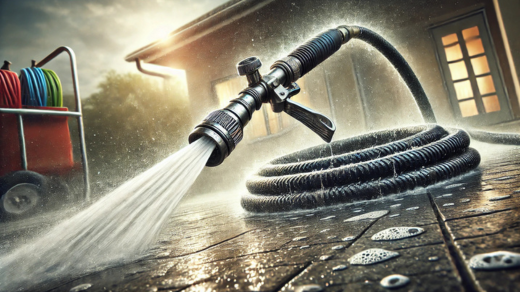Power washing is an essential task for maintaining the cleanliness and aesthetic appeal of your property. Whether you’re cleaning driveways, patios, or house siding, having the right equipment can make all the difference. At the heart of any power washing setup is the pressure washing hose. In this guide, we will explore the different types of power washing hoses available, their key features, maintenance tips, and how to choose the best high-pressure hose for your needs.
Understanding Power Washing Hoses
A power washing hose, also known as a pressure washing hose, is designed to handle the high-pressure water flow produced by power washers. These hoses must be durable, flexible, and resistant to damage, as they are often used in demanding conditions. Selecting the right power hose can enhance the efficiency of your cleaning tasks and prolong the life of your equipment.
Types of Power Washing Hoses
- PVC Hoses:
- Overview: PVC (polyvinyl chloride) hoses are lightweight and affordable, making them a popular choice for homeowners.
- Benefits: They are easy to maneuver and can handle moderate pressure levels, which is suitable for light residential cleaning tasks.
- Limitations: However, PVC hoses may not be as durable as other materials and can become brittle over time, especially when exposed to harsh weather conditions.
- Rubber Hoses:
- Overview: Rubber hoses are well-known for their durability and flexibility, making them ideal for high-pressure applications.
- Benefits: They can withstand extreme temperatures and are resistant to kinking, which is a common issue with other types of hoses. This makes them suitable for both residential and commercial use.
- Limitations: While rubber hoses are more expensive than PVC options, their longevity and performance make them worth the investment.
- Polyurethane Hoses:
- Overview: Polyurethane hoses offer a blend of flexibility and durability, making them an excellent option for various applications.
- Benefits: They are resistant to abrasions and UV damage, making them suitable for outdoor use. They are lightweight and easy to handle, ideal for both professionals and DIY enthusiasts.
- Limitations: While they provide good performance, they may not always handle the same high pressures as rubber hoses.
- High-Pressure Hoses:
- Overview: Specifically designed for heavy-duty power washing, high-pressure hoses can handle extreme pressure levels without bursting.
- Benefits: These hoses are typically made from reinforced materials, ensuring they can withstand rigorous use and high temperatures. If you’re frequently tackling tough cleaning jobs, investing in a high-pressure hose is essential.
- Limitations: They can be heavier and less flexible than other options, which may make them more challenging to maneuver.
Key Features to Look For
When choosing a power washing hose, several features are crucial to ensure you get the right product for your needs:
- Pressure Rating: Every hose has a specific pressure rating measured in PSI (pounds per square inch). Ensure the hose you select can handle the pressure output of your power washer. This is vital for safety and efficiency.
- Length: Power washing hoses come in various lengths, typically ranging from 25 to 100 feet. A longer hose allows you to reach distant areas without moving the power washer frequently, making your job easier.
- Diameter: The diameter of the hose affects the water flow. Most pressure washing hoses have diameters of 1/4 inch or 3/8 inch. A larger diameter generally provides higher flow rates, but ensure compatibility with your power washer.
- Fittings: Ensure the hose fittings match your power washer’s connections. Common fittings include quick-connects, threaded ends, and snap-on fittings. Selecting the right fittings ensures a secure and leak-free connection, minimizing the risk of water loss.
Maintenance Tips for Power Washing Hoses
Proper maintenance can significantly extend the life of your power washing hose and ensure optimal performance. Here are some tips to keep in mind:
- Store Properly: After use, always store your hose in a cool, dry place. Avoid leaving it exposed to direct sunlight, as UV rays can damage the material over time.
- Inspect Regularly: Before each use, inspect your hose for any signs of wear or damage, such as cracks, kinks, or leaks. Addressing these issues early can prevent more significant problems later and ensure your safety during operation.
- Clean After Use: After power washing, rinse the hose to remove any dirt, soap residue, or debris that may have accumulated. This helps prevent clogs and keeps the hose in good condition.
- Avoid Sharp Bends: When coiling your hose, avoid sharp bends or twists. This practice can help prevent damage and kinking, prolonging the life of the hose.
Conclusion
In conclusion, investing in the right power hose is crucial for achieving effective and efficient power washing results. By understanding the different types of hoses available, key features to consider, and maintenance tips, you can select a hose that meets your cleaning needs and enhances your power washing experience. Whether you’re a homeowner looking to maintain your property or a professional cleaner tackling tough jobs, the right power washing hose is an essential tool in your cleaning arsenal. Take the time to choose wisely, and you’ll enjoy a cleaner, more beautiful property for years to come.

